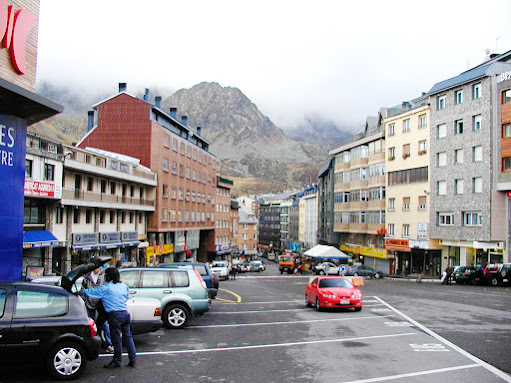Andorra
October 14, 2003
All but lost between France and Spain, like the fairy tale pea in the mattresses, the pocket-sized princedom of Andorra comprises just a handful of mountainous landscapes and meandering rivers. Though it is tiny, it contains some of the most dramatic scenery - and the best skiing - in the Pyrenees.
We drove through the entire country in maybe a couple of hours. Much less time would have been required if we had not stopped so often for views of the scenery, shops, and traffic.
For a quick overview, here are a few photos:
 |
| Downtown Pas de la Casa |
 |
| Wide view of Pas de la Casa |
 |
| Andorra Ski Area |
 |
| French Highway to Andorra |
Pre 20th Century History
Tradition credits Andorra's independence to Charlemagne, who captured the region from the Muslims in 803 AD. His son, Louis the Pious, presented the area's inhabitants with a charter of liberties. The earliest known document concerning Andorra is an order in 843 from Charlemagne's grandson, Charles II, granting the Valls d'Andorra (Valleys of Andorra) to Sunifred, Count of Urgell, from the nearby Spanish town of La Seu d'Urgell. The Act of Consecration for La Seu's cathedral, which dates from around 860, confirms Andorra's parishes as part of the count's territory.
The country's first constitutional documents, the Paretages (the Acts of Joint Overlordship), were drawn up in 1278 and 1288 to settle conflicting claims of seigniorial rights made by the Catholic Bishop of Urgell and the Count of Foix in France. These agreements, under which the bishop and count agreed to share sovereignty, form the basis of Andorra's government to this day and are among the oldest such documents still in force.
The peculiar political equilibrium created by the arrangement saved Andorra from being swallowed up by its powerful neighbors, despite recurrent tensions between the co-princes and the powers they represented. After the French Revolution, France - as inheritor of the lands and prerogatives of the Count of Foix - abolished all feudal rights, including the role of the French head of state in Andorran affairs. This was reinstated by Napoleon in 1806, at the request of the Andorrans, who feared Spanish hegemony.
Modern History
Andorra's modern role as a center for duty-free shopping grew out of the business of smuggling of French goods to Spain during the Spanish Civil War and Spanish goods to France during WWII. Andorra remained neutral throughout both world wars.
In March 1993, Andorrans voted to establish the country as an independent, democratic 'parliamentary co-principality', placing full sovereignty in the hands of the Andorran people, with the French and Spanish co-princes continuing to function as joint heads of state with greatly reduced powers. Andorra joined the Council of Europe in 1994.
Recent History
In recent years Andorra has maintained its status as a center for skiing and duty-free shopping. These activities are bringing the principality not just wealth, foreign workers and over 11 million visitors a year, but also unsightly development and heavy traffic for several kilometers on either side of the capital, Andorra la Vella.
Andorrans constitute a minority in their own country; only 33% of inhabitants hold Andorran nationality. The largest group of foreign nationals is that of Spaniards (43%), with Portuguese (11%) and French (7%) nationals the other main groups. The remaining 6% belong to several other nationalities.
The only official language is Catalan, the language of the nearby Spanish autonomous region of Catalonia, with which Andorra shares many cultural traits, though Spanish, Portuguese and French are also commonly spoken. The predominant religion is Roman Catholicism.

No comments:
Post a Comment